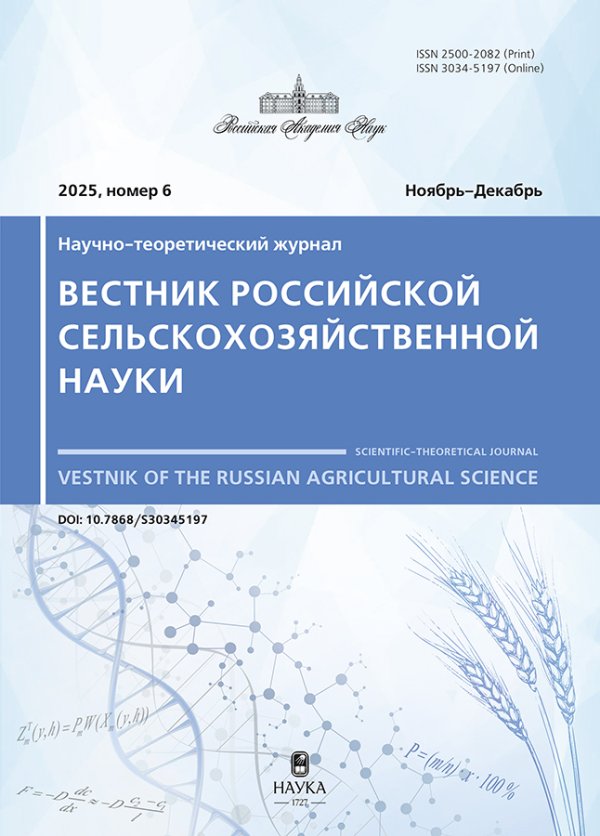Physico-Mechanical Properties and Architectonics of Stems as Indicators of Cereal Plants Resistance to Lodding
- Authors: Arinicheva I.V.1, Griguletsky V.G.1
-
Affiliations:
- Kuban State Agrarian University
- Issue: No 1 (2025)
- Pages: 42-46
- Section: Crop Production and Selection
- URL: https://journal-vniispk.ru/2500-2082/article/view/286056
- DOI: https://doi.org/10.31857/S2500208225010096
- EDN: https://elibrary.ru/CSUPSW
- ID: 286056
Cite item
Abstract
The increase in the yield of cereals, the main food product of the planet’s population, is the result of a modern approach to the process of growing and harvesting, the introduction of new techniques of breeding work, based, among other things, on the methods of mathematical modeling of the “ideal” variety – high-yielding and resistant to various unfavorable factors. Lodging of crops leads to significant losses of the crop, deterioration of its quality. Since ancient times, famous scientists have tried to describe the behavior of the stem as an elastic rod from the point of view of mathematics and technical mechanics. The article describes the methods we developed for determining the most important physical and mechanical properties of tissues (Young’s modulus, elasticity and yield strength limits) and the parameters of the architectonics of cereal plants (stem length, outer and inner diameters of the stem at the root and at the ear or panicle, weight of the ear, panicle or cob), which are statistically reliable and are used to build a lodging model. The obtained long-term data of field, vegetation and laboratory experiments are recommended to be used in breeding new varieties and hybrids resistant to lodging. Interdisciplinary research was conducted at the junction of biological and mathematical sciences to find the features of resistance to lodging of stems of winter and spring cereals depending on the variety and species. Stress-strain diagrams were constructed for all crops, all varieties and hybrids in three phases of vegetation, with the help of which we compiled an algorithm for selecting the optimal parameters of resistance to lodging of cereal plants.
Full Text
About the authors
I. V. Arinicheva
Kuban State Agrarian University
Author for correspondence.
Email: loukianova7@mail.ru
Grand PhD in Biological Sciences, Professor
Russian Federation, KrasnodarV. G. Griguletsky
Kuban State Agrarian University
Email: loukianova7@mail.ru
Grand PhD in Technical Sciences, Professor
Russian Federation, KrasnodarReferences
- Griguleckij V.G., Luk’yanova I.V. Vliyanie fiziko-mekhanicheskih svojstv rastenij na ih ustojchivost’ k poleganiyu // Trudy Kubanskogo gosudarstvennogo agrarnogo universiteta. 2000. № 382. S. 39–48.
- Divashuk M.G., Vasil’ev A.V., Bespalova L.A., Karlov G.I. Identichnost’ genov korotkostebel’nosti RHT-11 i RHT-V1E // Genetika. 2012. T. 48. № 7. S. 897.
- Acreche M.M., Slafer G.A. Lodging yield penalties as affected by breeding in Mediterranean wheats // J. Agric. 2010. Sci. 122. РP. 40–48.
- Berry P.M., Griffin J.M., Sylvester-Bradley R. et al. Controlling plant form through husbandry to minimize lodging in wheat // Field Crops Res. 2000. No. 67. PP. 59–81.
- Berry P.M, Sterling M, Spink J.H et al. Understanding and reducing lodging in cereals // Adv Agron. 2004. No. 84. PP. 215–269.
- Bespalova L.A., Borovik A.N., Miroshnichenko T.Yu. Triticale sphaerococcum – a new perspective direction of breeding // 2nd International Conference on Triticale and Wheat Biology, Breeding and Production Book of Abstracts. 2018. PP. 26.
- Berry P.M., Sterling M., Spink, J.H. et al. Understanding and reducing lodging in cereals // Adv. Agron. 2004. No. 84. PP. 217–271.
- Dietrich R.C., Bengough A.G., Jones H.G., White P.J. Can root electrical capacitance be used to predict root mass in soil? // Ann. Bot. 2013. No. 112. PP. 457–464.
- Ellis T.W., Murray W., Paul K. et al. Electrical capacitance as a rapid and non–invasive indicator of root length // Tree Physiol. 2012. No. 33. PP. 3–17.
- Foulkes M.J., Slafer G.A., Davies W.J. et al. Raising yield potential of wheat. III. Optimizing partitioning to grain while maintaining lodging resistance // J. Exp. Bot. 2011. No. 62. PP. 469–486.
- Ookawa T. Inoue K., Matsuoka M. et al. Increased lodging resistance in long–culm, low–lignin gh2 rice for improved feed and bioenergy production // Sci. Rep. 2014. No. 4. PP. 65–67.
Supplementary files














